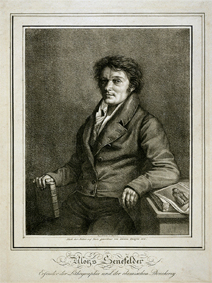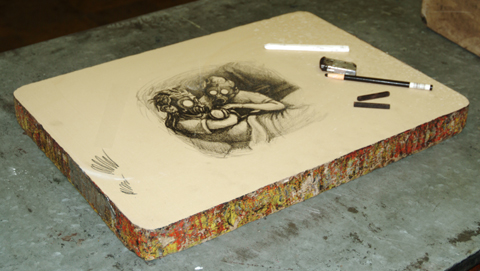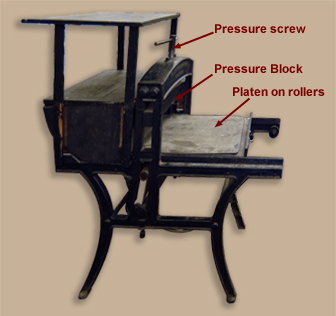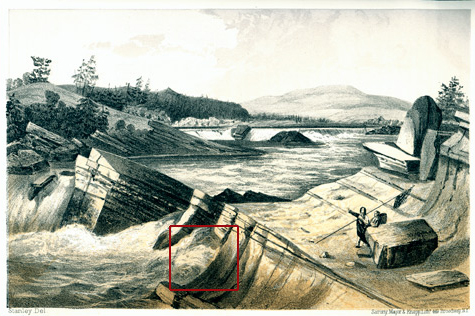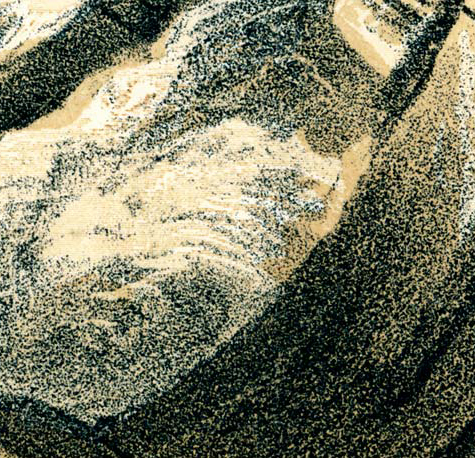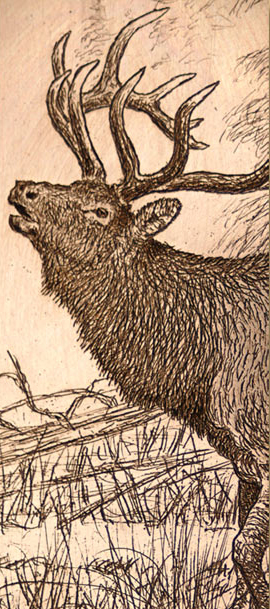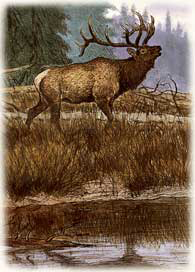Before the Lewis and Clark expedition was conceived, while it was under way, and for several decades after it was completed, the technology known as lithography, that would open up its visual history to a wider audience, lay dormant.
In 1798 a German actor-playwright-turned-printer named Alois Senefelder (1771-1834) discovered the principle of lithography, relying upon simple chemical principles—the mutual repulsion of oil and water, and the mutual attraction of water and salt.
“Stone-printing”
A design or picture, including text, is drawn on the delicately grainy, slightly porous limestone[1]In Senefelder’s day the best limestone for lithography was found only near Solnhofen, between Munich and Nuremberg on the Danube River in Bavaria, in a fossilized late Jurassic mud bank that … Continue reading surface with a wax crayon or a black greasy concoction called tusche. A mixture of gum Arabic and nitric acid is brushed over the stone, which is then dusted with resin and powdered talc, forming a barrier around all the parts of the image and sealing the exposed stone. The stone is then moistened with water, which is attracted to the salt layer but repelled by the wax image. An oily ink, which is repelled by the water but attracted by the wax base, is rolled over the image. A sheet of paper is placed over the image and scraped with a leather-covered pressure block to transfer the inked image onto the paper. The result, in the lingo of the present digital age is (pronounced exactly as it is spelled), WYSIWYG—”What You See Is What You Get.” In other words, lithography brought the artist many steps closer to the printed version of his work than ever before.
Senefelder patented his technique throughout Europe, but did not publicize the details of what he called “stone-printing” or “chemical printing” until 1818. The following year his book appeared in English as A Complete Course of Lithography; which remained the standard guide to the process until the early 20th century.
The transition from engraving to lithography was slow. The first lithograph in the U.S. was printed in 1818; New York had a lithographer in business in 1821; but it was 1829 before anyone in Philadelphia joined the trend.[2]Victor Strauss, ed., The Lithographer’s Manual: A Compendium of Lithography, 2 vols. (New York: Waltwin Publishing Company, 1958), 1:4. Between 1827 and 1839 John James Audubon, who quickly became the most famous of all American natural history artists, published The Birds of North America as hand-colored copperplate engravings, with a few etchings and aquatints included. However, the three-volume Audubon-Bachman Quadrupeds of North America, begun in 1839 and completed in 1852, consisted of 150 lithographs by the talented William Hitchcock and hand-colored by J. T. Bowen under the artist’s supervision. Samples of their work can be seen in Western Whitetail Deer, Columbian Black-Tailed Deer, and in the lithographs based on the drawings that Titian Ramsay Peale (1799-1885) made in 1819-20 for the Stephen Long expedition, including his depiction of a mule deer.
Solnhofen Limestone
At right are wax and oil-based crayons and a special kind of (white) eraser. The fine-grained texture of Solnhofen limestone produces a continuous-tone, dark-to-light shade as the pressure on the crayon varies. The heavier the pressure, the more the spaces between the grains are filled in with wax.The edge of this stone bears a record of its working history in dribbles of the colors of ink used. Courtesy, studio of James Bailey.
A 19th-Century Transfer Press
A lithographic press of the type used during much of the 19th-century, prior to the introduction of electrically-powered rotary presses around the beginning of the 20th century. Courtesy, studio of James Bailey.
WYSIWYG
The advantages of lithography established a new era in the printing of graphics. It stimulated an increasing popular interest in printed illustrations. For example, and by far the most familiar example, the Boston-based partnership of Currier & Ives made lithography a household word, documenting a broad spectrum of everyday life in 19th-century America from 1835 until the beginning of the 20th century. They established wholesale outlets throughout the U.S., unashamedly touting their prints—which today are the epitome of the best in kitsch—as “Cheap and Popular Pictures,” popularly referred to as “wall-hangings.” Currier and Ives ultimately turned out more than 7,000 reality-based lithographs in runs sometimes of thousands of copies each, catering to a mass market, and priced accordingly. Currier, who was the print publisher, was not equipped to produce chromolithographs, so robust colors were added to black-and-white prints in the old-fashioned way, by a crew of a dozen or more women wielding brushes in production lines, one color per painter.
Whereas engraving involved a succession of steps, required proofing at every step, and allowed only comparatively minor corrections, a lithograph basically required one step and one proof. Consequently it was faster and therefore cheaper—generally, one-seventh the cost of copperplate engraving. As many as 30 or 40 lithographs could be “pulled”—finished, except for drying—in an hour, whereas high-quality engravings and etchings of comparable size could be produced at the rate of seldom more than six per hour. Although the Solnhofen limestone was considerably more expensive than copperplate to import, a stone could be erased, or “grained,” with carborundum, and could be used for thousands of successive images, whereas a used copperplate could be difficult if not impossible to recycle. Above all, it relieved the artist of any necessity to surrender the key steps in graphic reproduction to assistants, unless he chose to.
Color lithography, sometimes called chromolithography, emerged around 1850, but was not widely used until after the Civil War. The procedure required the use of several stones, one bearing the key image, the rest for areas or washes of different colors, which were printed successively on the same sheet of paper. A greater variety of effects was eventually achieved by overprinting colors. In both cases, the precise alignment, or “registration,” of the successive stone plates on the press—each weighing between 100 and 200 pounds, was the main technical challenge.
Chromolithography
Kettle Falls, (1855)[3]Reports of Explorations and Surveys, to Ascertain the Most Practicable and Economical Route for a Railroad from the Mississippi River to the Pacific Ocean, M ade Under the Direction of the Secretary … Continue reading
by John Mix Stanley (1814–1872)
Stevens, Reports and Surveys (1855), Plate 45.
The red square outlines the detail enlarged below.
The detail at right, enlarged approximately 55 times, shows part of the key image, consisting of a full range of densities from solid through very light tones, which have been created by drawing with a wax crayon on the minutely pebbly surface of the stone. The key has been printed in a dark green ink (No. 1, below). Two shades of tan (No’s. 2, 3) applied to selected areas of the image, have been overprinted from separate stones.

2

3

Beginning early in the 20th century, photographic half-tone reproduction processes,[4]Half-tone color printing, which is still the standard method of print reproduction, involves the breaking-up of images into dots by photographing them through screens that produces between 50 and 150 … Continue reading as well as the introduction of four-color presses, replaced lithography in the commercial printing industry. Still, chromolithography has remained highly valued as an artistic medium, inspired by the work of major artists such as Théodore Géricault (1791-1824), Honoré Daumier (1808-1879), Pablo Picasso (1881-1973), and Salvador Dali (1904-1989). Yet the historic engravings and lithographs that illuminated the story of the Lewis and Clark expedition during its first century are reminders of the technologies that first shed the light.
The author gratefully acknowledges the assistance of Prof. James Bailey.
Notes
| ↑1 | In Senefelder’s day the best limestone for lithography was found only near Solnhofen, between Munich and Nuremberg on the Danube River in Bavaria, in a fossilized late Jurassic mud bank that cleaves easily into thin layers. A two-foot-thick layer of similar limestone has since been discovered in Iowa. |
|---|---|
| ↑2 | Victor Strauss, ed., The Lithographer’s Manual: A Compendium of Lithography, 2 vols. (New York: Waltwin Publishing Company, 1958), 1:4. |
| ↑3 | Reports of Explorations and Surveys, to Ascertain the Most Practicable and Economical Route for a Railroad from the Mississippi River to the Pacific Ocean, M ade Under the Direction of the Secretary of War, in 1853–55. 12 vols. (Washington, D.C.: Thomas H. Ford, 1860) Vol. 12, Part 1, Plate 45. |
| ↑4 | Half-tone color printing, which is still the standard method of print reproduction, involves the breaking-up of images into dots by photographing them through screens that produces between 50 and 150 or more dots, or “lines,” per inch. The dot pattern is exposed, or “burned,” onto a printing plate—metal for longer press runs or even paper for very short or low-priced runs. The basic four-color process combines cyan (blue), magenta (red), yellow, and black inks into a full range of colors by running the paper through a printing press four times, one color per impression, or once through a linked series of four presses. Fine-art prints, or tint-sensitive scientific artwork, may be separated into more than four colors—eight to twelve or more. Digital technology, which dates from the late 1980s, translates every value into pixels, which in turn are expressed in strings of ones and zeroes. |
Experience the Lewis and Clark Trail
The Lewis and Clark Trail Experience—our sister site at lewisandclark.travel—connects the world to people and places on the Lewis and Clark Trail.
Discover More
- The Lewis and Clark Expedition: Day by Day by Gary E. Moulton (University of Nebraska Press, 2018). The story in prose, 14 May 1804–23 September 1806.
- The Lewis and Clark Journals: An American Epic of Discovery (abridged) by Gary E. Moulton (University of Nebraska Press, 2003). Selected journal excerpts, 14 May 1804–23 September 1806.
- The Lewis and Clark Journals. by Gary E. Moulton (University of Nebraska Press, 1983–2001). The complete story in 13 volumes.
